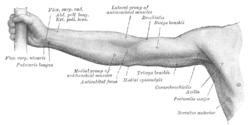Upper limbs
| Upper limb | |
|---|---|

Front of right upper extremity.
|
|

Back of right upper extremity.
|
|
| Details | |
| System | Musculoskeletal |
| Identifiers | |
| Latin | membrum superius |
| MeSH | Extremity A01.378.800 |
| TA | A01.1.00.019 |
| FMA | 7183 |
|
Anatomical terminology
[]
|
|
The upper limb or upper extremity is the region in a vertebrate animal extending from the deltoid region to the hand, including the arm, axilla and shoulder.
In formal usage, the term "arm" only refers to the structures from the shoulder to the elbow, explicitly excluding the forearm, and thus "upper limb" and "arm" are not synonymous. However, in casual usage, the terms are often used interchangeably. The term "upper arm" is redundant in anatomy, but in informal usage is used to distinguish between the two terms.
The muscles of the upper limb can be classified by origin, topography, function, or innervation. While a grouping by innervation reveals embryological and phylogenetic origins, the functional-topographical classification below reflects the similarity in action between muscles (with the exception of the shoulder girdle, where muscles with similar action can vary considerably in their location and orientation.
The shoulder girdle or pectoral girdle, composed of the clavicle and the scapula, connects the upper limb to the axial skeleton through the sternoclavicular joint (the only joint in the upper limb that directly articulates with the trunk), a ball and socket joint supported by the subclavius muscle which acts as a dynamic ligament. While this muscle prevents dislocation in the joint, strong forces tend to break the clavicle instead. The acromioclavicular joint, the joint between the acromion process on the scapula and the clavicle, is similarly strengthened by strong ligaments, especially the coracoclavicular ligament which prevents excessive lateral and medial movements. Between them these two joints allow a wide range of movements for the shoulder girdle, much because of the lack of a bone-to-bone contact between the scapula and the axial skeleton. The pelvic girdle is, in contrast, firmly fixed to the axial skeleton, which increases stability and load-bearing capabilities.
...
Wikipedia
